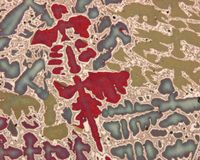
The morphology, molecular development and ecological function of pseudonectaries on Nigella damascena (Ranunculaceae) petals
Sign Up to like & getrecommendations! Published in 2020 at "Nature Communications"
DOI: 10.1038/s41467-020-15658-2
Abstract: Pseudonectaries, or false nectaries, the glistening structures that resemble nectaries or nectar droplets but do not secrete nectar, show considerable diversity and play important roles in plant-animal interactions. The morphological nature, optical features, molecular underpinnings… read more here.
Keywords: nigella damascena; damascena ranunculaceae; molecular development; development ... See more keywords

Distribution area of the two floral morphs of Nigella damascena L. (Ranunculaceae): a diachronic study using herbarium specimens collected in France
Sign Up to like & getrecommendations! Published in 2018 at "Botany Letters"
DOI: 10.1080/23818107.2017.1422437
Abstract: Abstract Perianth dimorphism in Nigella damascena (Ranunculaceae) has been documented for four centuries, and its genetic basis started to be studied almost a century ago. Based on herbarium collections, we reconstructed the evolution of the… read more here.
Keywords: distribution area; damascena ranunculaceae; herbarium; nigella damascena ... See more keywords

A MITE insertion abolishes the AP3-3 self-maintenance regulatory loop in apetalous flowers of Nigella damascena.
Sign Up to like & getrecommendations! Published in 2022 at "Journal of experimental botany"
DOI: 10.1093/jxb/erac489
Abstract: MADS-box transcription factors are important regulators of floral organ identity through their binding to specific motifs, termed CArG, in the promoter of their target genes. Petal initiation and development depend on class A and B… read more here.
Keywords: nigella damascena; expression; mite insertion; insertion ... See more keywords

Transcriptome Analysis Reveals Putative Target Genes of APETALA3-3 During Early Floral Development in Nigella damascena L.
Sign Up to like & getrecommendations! Published in 2021 at "Frontiers in Plant Science"
DOI: 10.3389/fpls.2021.660803
Abstract: Even though petals are homoplastic structures, their identity consistently involves genes of the APETALA3 (AP3) lineage. However, the extent to which the networks downstream of AP3 are conserved in species with petals of different evolutionary… read more here.
Keywords: target genes; genes apetala3; nigella damascena; putative target ... See more keywords

Thermal Characterization of Extracts Obtained from Different Parts of Nigella damascena (Ranunculaceae) by TG and DSC
Sign Up to like & getrecommendations! Published in 2017 at "Revista De Chimie"
DOI: 10.37358/rc.17.5.5599
Abstract: The increased search for herbal products has generated an increasing interest in improving the quality control of extracts by pharmaceutical industry since these are raw materials of great importance by their quality and versatility. Thermal… read more here.
Keywords: methodology; thermal characterization; dsc; characterization extracts ... See more keywords